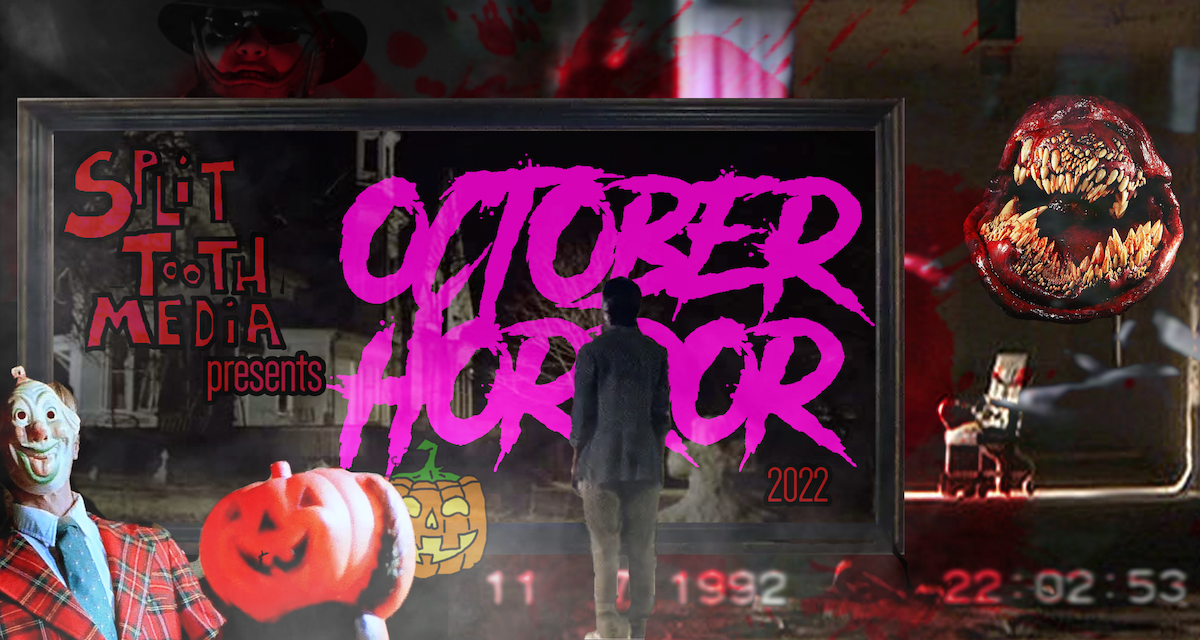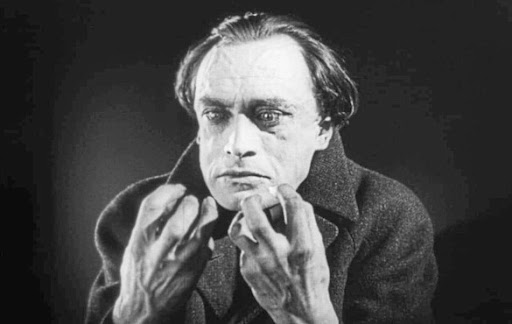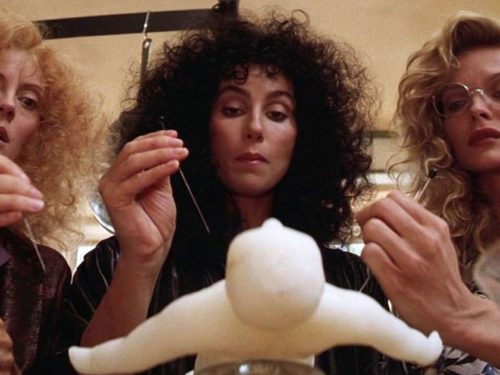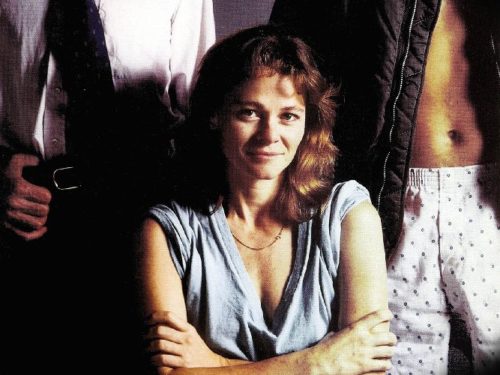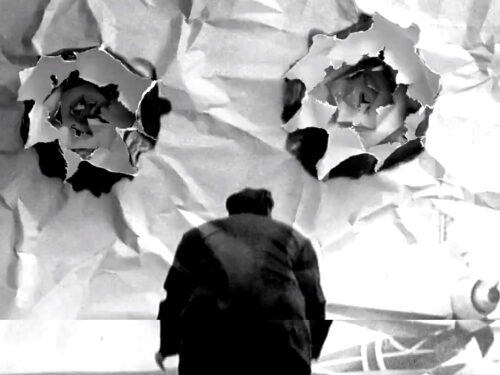This essay is part of a series on films that deal with art, the artist, and the artistic experience. In the first of a three-part series on the many adaptations of Maurice Renard’s 1920 novel The Hands of Orlac, Steve Collins looks at Robert Wiene’s 1924 silent classic starring Conrad Veidt
There’s a little secret of horror film history involving a source novel outside the standard canon of scary stories that keeps getting adapted and reinterpreted for the screen: Maurice Renard’s The Hands of Orlac (1920). It all began with Robert Wiene’s 1924 silent film. Karl Freund’s Mad Love followed in 1935. Then a new version seemed to appear with each new decade — even every few years: The Beast with Five Fingers (1946), The Hands of Orlac (1960), The Hands of a Stranger (1962), The Hand (1981), Body Parts (1991), and Roxana’s Hands (2012). What is it about this story that keeps filmmakers coming back to the well? The original novel follows a concert pianist who loses his hands in a train accident and has them surgically replaced with the hands of an executed murderer. It’s a great elevator pitch and a dark playground for filmmakers to explore the mysterious connection between the body and the soul. The many Orlac variations shift the focus of the story to different characters and alter details of setting and time. Depending on the film, the suffering artist is a painter, a musician, an actor, even a cartoonist, but they are all concerned with that other mystery we don’t understand: where does art come from?
The horrific image of severed hands is a potent match for the battle within an artist when the flow of creativity is blocked. It’s no surprise that the German Expressionists and their brethren flocked to Renard’s novel. Robert Wiene, most famous for The Cabinet of Dr. Caligari (1920), recognized Orlac as a story where the external reality of the visuals could match the internal world of the titular tortured artist. Wiene cast Conrad Veidt, whom he had directed to international fame as Caligari’s somnambulist Cesare, as Paul Orlac. The director and actor were an ideal pair for translating inner anguish into something we could see on screen. Wiene turns the train wreck that severs Orlac’s hands into a jagged display of shadow and steel. Rescue workers search over the crash site, their lanterns struggling through the smoke, their bodies crawling over twisted metal and death. The haunting sequence lays down the initial imagery of physical destruction that helps Orlac’s inner destruction resonate so deeply.
Veidt’s performance is a masterpiece of transforming psychology into physical movement. After Orlac returns home from his operation, he shuffles to his piano to try out his new hands. His living room is cavernous – 30 foot walls and no apparent ceiling. Its furniture consists of one piano, one sharp angular patterned rug, some seating a mile away on a back wall, and a yawning emptiness. The piano is lit up within this cathedral and draped in shadow like a coffin at the center of a funeral. Watching Veidt traverse across such a severe setting, you see how well silent filmmakers and actors understood the meaning of moving pictures.
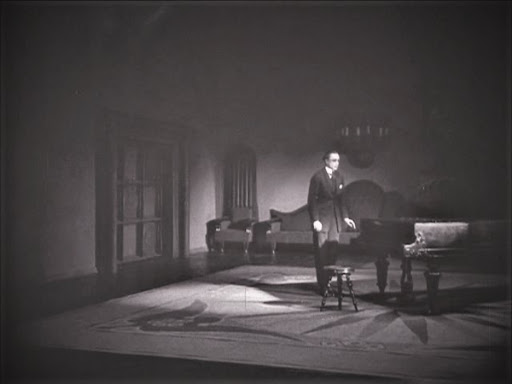
Veidt arrives at the piano and puts his arms around the instrument as if in an embrace. It’s a gesture that could be comical if not set in such a lonely abyss and performed with such nakedness. Orlac lifts the cover. His hands — contorted in a rigor mortis-like coil — hover over the keys. His wife, Yvonne (Alexandra Sorina), approaches from the doorway, watching at a distance. The stretch of space between them speaks to his emotional isolation. Orlac lowers his hands and plays. Wiene’s Orlac may be silent, but Yvonne’s dismay is deafening: the music no longer flows through her husband’s hands.
Orlac’s failure at the piano is essentially a scene of writer’s block. In the artist film, a creative block is given the same weight as a standoff between great opposing warriors, because without expression, there is madness and death ahead for the artist. Unlike a fight between Godzilla and Mothra, an artistic block is a hard battle to put on film. If the artist could get ahold of the block, they’d certainly rip it out and throw it into Tokyo Bay, but the trouble is that their battle is an internal one. The Hands of Orlac makes an artistic block a physical thing by cutting off the hands of the artist and surgically adhering the new “killer” hands of the convicted murderer Vasseur, who was famous for his knife-throwing skills (yes, this will come up later). The artist’s job is to express themselves through their art and Orlac is now literally both himself, and not himself. What initially could be described as a medical problem of tendons and tissue becomes an issue of identity.
Vasseur and his killer hands haunt Orlac from the moment he wakes from surgery and creates opportunities for Wiene to visualize his protagonist’s anguish. We learn Vasseur was beheaded for his crimes on the day of Orlac’s train accident, and the pianist sees a strange disembodied face appear outside his hospital room window — the neck underlit and bisected by the frame, as if severed and floating. Then he hallucinates the same head from his sickbed, now actually floating, large and looming over him in a cloud of smoke that fills his high-ceilinged room. Immediately following, a striking superimposition of Vasseur’s hand reaches from above to Orlac, who recoils in his bed. When he returns home from the Hospital, one of Vasseur’s knives is stuck in his living room wall, ominously marked with an “x” on the tip of the handle. Orlac buries this “x” knife under the hood of his piano, an unnerving image of bottled psychology that helps carry us into Orlac’s war of self-doubt. With these pieces of Vasseur and Orlac, hands and heads, knives and piano keys, Wiene stirs Orlac’s crisis into a visual stew.
No longer able to play music, the horror of Orlac’s inability to perform begins to play out. Paul and Yvonne fall into financial trouble and in desperation Yvonne solicits help from her father-in-law. Wiene’s presentation of Orlac’s father ensures there is no need for flashbacks into the familiar expository scenes of an artist’s difficult childhood. Mr. Orlac resides in another of the film’s cavernous interiors, sitting deep in shadow upon a kind of wooden throne — like a cheap king who won’t pay for candles. So many of the rooms in the film have the feng-shui of an asylum, straight-jacketing us to Orlac’s inner crisis. The sterile décor, and thick shadows of the room stand in for the storm that brews inside of Orlac. Yvonne begs Mr. Orlac to intervene lest they be “ground into Earth.” The father responds, “Yes, I would like that! I hate him!” He’s nothing if not a clear communicator.
Denied the money, Orlac goes to confront his father himself; He finds him dead, one of Vasseur’s ‘x’ marked knives in his back. (Told you it would come up again!) It’s a compromising position, considering Orlac’s motive and the previous owner of his hands. Fleeing the scene, he runs into a man on the way out who reveals himself to be Vasseur with grotesque metal hands and a head transplant scar to prove it. When the villain proceeds to blackmail Orlac, threatening to turn him into the police, it’s as if Orlac’s self-loathing has materialized into this Frankenstein re-creation of Vasseur: disfigured Orlac facing disfigured Vasseur is the artist staring into the mirror of doubt. It could be all in Orlac’s head, but when the police discover the fingerprints of his new hands all over the knife in Orlac Sr.’s back, it looks bad for our pianist.
The reason this all seems plausible is not the logic of it — no one really believes transplanted murder hands could make you a murderer — but because of the emotional truths of Orlac’s trauma, the horror of losing control of who you are. The Hands of Orlac uses the artist to explore the fragility of our souls. With enough damage, the complex internal mechanism that allows beauty to pass through the body and produce art can be tweaked to deliver knives.
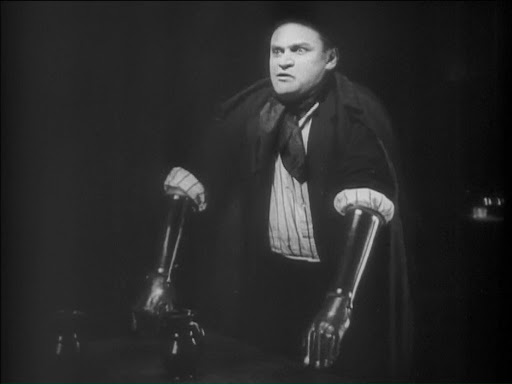
Before the blackmail can pay off, detectives reveal in a blaze of exposition that Orlac is being manipulated by a conman named Nera, an associate of Vasseur, who has been planning a complicated scheme that includes the following: fake metal hands that fit like gloves over real hands, a fake guillotine scar applied with adhesive, rubber gloves with his dead friend Vasseur’s fingerprints on them. It’s a lot to absorb. The exposition ends with a reveal that the deceased Vasseur himself was innocent and framed by Nera, which means there’s nothing evil in Orlac’s hands after all: “They are pure.”
What’s unique to The Hands of Orlac on screen as opposed to the novel is that seeing is believing. The act of seeing skews our judgment of what that final intertitle tells us. At the end of the film, it is very hard for us to think of Orlac’s hands as “pure” because we’ve been dragged through this wild goose chase of severed body parts and the crippling self-doubt that assembled a Franken-killer inside Orlac. We’ve seen nothing but images of violence and shadow.
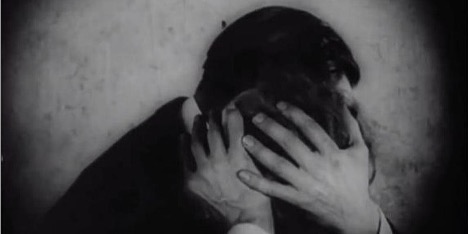
Critics have complained about the film’s convoluted ending and Orlac’s quickly determined innocence, but by definitively removing the possibility of surgically attaching evil, the film doubles down on just how much the artist, and not the supernatural, can be their own antagonist. The film’s last frame is Yvonne and Paul Orlac embracing in a kiss, Paul’s hands wrapped around her, almost smothering her face and head. We are left with a visual question: What is inside those hands? Are we seeing an artist rehabilitated or a potential murderer? Orlac’s worst self is not transplanted, but rather comes from within. Even though the pianist has been proven innocent and the Vasseur con exposed, something still throbs within this image of Orlac’s hands that feels both unknowable and completely familiar. Ultimately, The Hands of Orlac is about the horror of imbalance when artistic expression can’t get out of the artist’s body. The final image of Orlac’s hands contains the horror of evil and the wonder of art, both pointing to the ineffability of the soul.
Pt. 2 of The Many Hands of Orlac on Karl Freund’s Mad Love (1935) arrives Friday, Oct. 21.
Stay up to date with all things Split Tooth Media and stream Steve Collins’ latest film, I’ve Got Issues
(Split Tooth may earn a commission from purchases made through affiliate links on our site.)
Find the complete October Horror 2022 series here:
